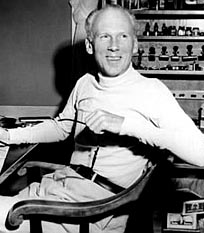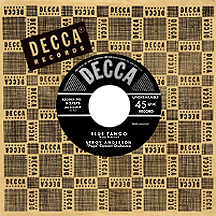LEROY ANDERSON
Blue Tango
In which direction could a would-be serious musician sway? Might he or she prefer to follow strict classical form or the allegedly more lowbrow application of "Pops" concert music? Dedicated practitioners often reach a point of having to choose between making a living at it (the second option) or accepting the occasional period of involuntary fasting that comes with remaining true to the classics of the 18th century (pretty stodgy stuff, some reckon) or attempting to master the more exciting construct of the 19th century's romantic period (though it's not universally considered pure classical music). You can't really blame Henry Lee Higginson of The Boston Symphony Orchestra for targeting blue collar music fans with his variety-filled Promenade concerts in the 1880s and '90s. The public embraced his concept and the series was eventually identified as the Boston "Pops." A new musical hybrid for the 20th century had been established combining classic works and trendier popular songs.
The most renowned original song of the "Pops" movement arrived more than a half-century later. "Blue Tango" merged the rhythm of the South American dance in its title with a classical-influenced arrangement; the recording by its composer, Leroy Anderson, hit the best seller list at the end of 1951, went to number one in the spring of '52, spent a full six months in the top ten and remained on the chart through the end of September, selling over two million copies in the process. Anderson was 43 at the time, a virtuoso composer and conductor who coincidentally had cut his teeth with The Boston Pops as an arranger under the orchestra's famous conductor Arthur Fiedler. Leroy's parents had emigrated from Sweden as children; they married in 1907, a year before his birth, and made their home in Cambridge, Massachusetts, directly across the Charles River from Boston, not three miles from Fiedler's future headquarters in Symphony Hall.
Leroy's mother began teaching him piano when he was five; within a few years he was taking professional lessons and by high school he had also become proficient at trombone, tuba and double bass. He attended Harvard in the late 1920s and early '30s, earning degrees in music while mastering several Scandinavian languages. With the "Pops" opportunity in such close proximity, it was inevitable he and Fiedler would one day cross paths. Word got out about his musical arrangements for some of Harvard's Hasty Pudding theater shows, which led to a meeting with the mustachioed master in 1936 and an opportunity to contribute compositions for the orchestra's performances. "Jazz Pizzicato" and "Jazz Ligato" in 1938 and '39 established Anderson with the Pops before he was drafted by the U.S. Army, just in time to serve during World War II. After the war he resumed writing music and conducted the Pops at the premieres of two of his compositions, "The Syncopated Clock" and "Promenade," in 1946.

He and his wife Eleanor spent a hot summer in Woodbury, Connecticut, at which time work began on what is arguably his best-known piece, "Sleigh Ride," originally intended as winter-themed but not necessarily connected to Christmastime. He completed it in early 1948 after moving to Brooklyn and Fiedler flipped; not waiting for winter to roll around again, the Boston Pops introduced the number, with its clip-clop effects and trumpeted horse whinny, at a performance of the orchestra on May 4. RCA Victor eventually decided to release the Boston Pops version as a Christmas single and it reached the top 30 in December 1949. Shortly afterwards, lyrics were added by Mitchell Parish (who, two decades earlier, had famously supplied words for Hoagy Carmichael's "Star Dust," making it one of the most popular tunes of all time). Decca's Andrews Sisters recorded "Sleigh Ride" for the 1950 holiday season; among the countless recordings of the song, vocal interpretations by Johnny Mathis (in 1958) and The Ronettes (in 1963) have stood the test of time.
In 1950, Anderson signed his own solo contract with Decca Records, and while Fiedler's Pops had premiered several of his works and struck first with "Sleigh Ride," it was Leroy's version of his metronomic "The Syncopated Clock" that became a hit in the spring of 1951 (the Boston Pops put out a near-identical take that briefly charted). Parish penned lyrics for this one as well, but the instrumental triumphed as the definitive rendition (WCBS-TV, channel 2 in New York City, began using the song as the theme for its Late Show movies, permanently embedding the hook in many a night owl's brain over the next two decades). Then "Blue Tango" blew away all previous works with its impressive sales, fending off competing versions from bandleaders with bigger names; Hugo Winterhalter, Les Baxter and Guy Lombardo all made the sales surveys (and in 1960 it was successfully revived by Bill Black's Combo). Lyrics were written, once again by Mitchell Parish, and published that summer: 'Here am I with you...in a world of blue...and we're dancing to the tango...'
While "Blue Tango" unexpectedly ruled the 1952 music scene, Decca went ahead and released singles of other light-classical-style Anderson tunes, "The Penny-Whistle Song" and "A Trumpeter's Lullaby." They weren't particularly strong sellers, but one, "Plink! Plank! Plunk!," was later used as the theme for CBS-TV's popular game show I've Got a Secret, hosted by Garry Moore. Late in the year, Leroy's own single of "Sleigh Ride" finally appeared on Decca and quickly became, and has remained, the most-played version of the song each holiday season. Another yuletide disc arranged and conducted (but not composed) by Anderson was issued at that time, the double-sided "A Christmas Festival" with a medley of nine seasonal standards. In '53 his recording of "The Typewriter" tested the limit with nonstop "typing-ding!" sound effects, adding itself to the frequently-used TV-and-radio production file.
A romantic 1954 album track, "Forgotten Dreams," was mildly popular three years later, then in October of 1958 the musical production Goldilocks, featuring his score, opened on Broadway. With longtime cohort Arthur Fiedler at the controls, Leroy Anderson did his part to invigorate America's 20th century "Pops" obsession. The decision to pursue his career on the more lucrative, commercial outskirts of the classical music world was never really an option, it was just the way things fell into place for the incredibly talented composer who happened to live within a stone's throw of Fiedler's Boston Pops operation.


